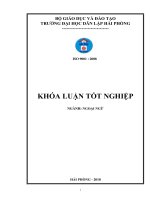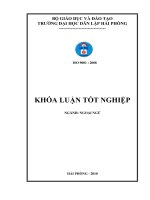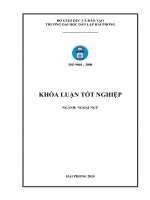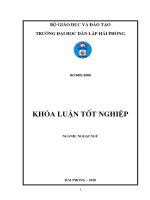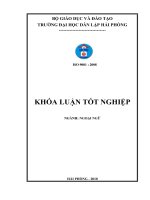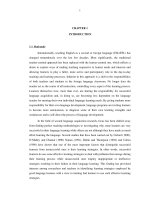A study on English brief news headlines
Bạn đang xem bản rút gọn của tài liệu. Xem và tải ngay bản đầy đủ của tài liệu tại đây (640.96 KB, 64 trang )
BỘ GIÁO DỤC VÀ ĐÀO TẠO
TRƯỜNG ĐẠI HỌC DÂN LẬP HẢI PHÒNG
-------------------------------
ISO 9001 : 2008
KHÓA LUẬN TỐT NGHIỆP
NGÀNH: Ngo¹I ng÷
HẢI PHÒNG - 2010
HAIPHONG PRIVATE UNIVERSITY
FOREIGN LANGUAGES DEPARTMENT
-----------------------------------
ISO 9001 : 2008
GRADUATION PAPER
A study on English brief news headlines
By:
PHAN THỊ NGỌC HÀ
Class:
NA 1002
Supervisor:
NGUYỄN THỊ THU HUYỀN, M.A.
HAI PHONG - 2010
BỘ GIÁO DỤC VÀ ĐÀO TẠO
TRƯỜNG ĐẠI HỌC DÂN LẬP HẢI PHÒNG
--------------------------------------
Nhiệm vụ đề tài tốt nghiệp
Sinh viªn: ......................................................M· sè: ...............................
Líp:.............................Ngành: ................................................................
Tªn ®Ò tµi : .............................................................................................
..............................................................................................
..............................................................................................
Nhiệm vụ đề tài
1. Nội dung và các yêu cầu cần giải quyết trong nhiệm vụ đề tài tốt
nghiệp ( về lý luận, thực tiễn, các số liệu cần tính toán và các bản vẽ).
……………………………………………………………………………..
……………………………………………………………………………..
……………………………………………………………………………..
……………………………………………………………………………..
……………………………………………………………………………..
……………………………………………………………………………..
……………………………………………………………………………..
……………………………………………………………………………..
2. Các số liệu cần thiết để thiết kế, tính toán.
……………………………………………………………………………..
……………………………………………………………………………..
……………………………………………………………………………..
……………………………………………………………………………..
……………………………………………………………………………..
……………………………………………………………………………..
……………………………………………………………………………..
……………………………………………………………………………..
……………………………………………………………………………..
3. Địa điểm thực tập tốt nghiệp.
……………………………………………………………………………..
……………………………………………………………………………..
……………………………………………………………………………..
CÁN BỘ HƯỚNG DẪN ĐỀ TÀI
Người hướng dẫn thứ nhất:
Họ và tên: ..................................................................................................
Học hàm, học vị: .......................................................................................
Cơ quan công tác:.......................................................................................
Nội dung hướng dẫn: .................................................................................
Người hướng dẫn thứ hai:
Họ và tên: ...................................................................................................
Học hàm, học vị: ........................................................................................
Cơ quan công tác:.......................................................................................
Nội dung hướng dẫn: .................................................................................
Đề tài tốt nghiệp được giao ngày 12 tháng 04 năm 2010
Yêu cầu phải hoàn thành xong trước ngày 10 tháng 07 năm 2010
Đã nhận nhiệm vụ ĐTTN
Đã giao nhiệm vụ ĐTTN
Người hướng dẫn
Sinh viên
Hải Phòng, ngày tháng năm 2010
HIỆU TRƯỞNG
GS.TS.NGƯT Trần Hữu Nghị
PHẦN NHẬN XÉT TÓM TẮT CỦA CÁN BỘ HƯỚNG DẪN
1. Tinh thần thái độ của sinh viên trong quá trình làm đề tài tốt
nghiệp:
………………………………………………………………………………
………………………………………………………………………………
………………………………………………………………………………
………………………………………………………………………………
………………………………………………………………………………
………………………………………………………………………………
………………………………………………………………………………
………………………………………………………………………………
2. Đánh giá chất lượng của khóa luận (so với nội dung yêu cầu đã đề ra
trong nhiệm vụ Đ.T. T.N trên các mặt lý luận, thực tiễn, tính toán số
liệu…):
……………………………………………………………………………..
……………………………………………………………………………..
……………………………………………………………………………..
……………………………………………………………………………..
……………………………………………………………………………..
……………………………………………………………………………..
……………………………………………………………………………..
……………………………………………………………………………..
……………………………………………………………………………..
3. Cho điểm của cán bộ hướng dẫn (ghi bằng cả số và chữ):
……………………………………………………………………………..
……………………………………………………………………………..
……………………………………………………………………………..
Hải Phòng, ngày ….. tháng ..… năm 2010
Cán bộ hướng dẫn
(họ tên và chữ ký)
NHẬN XÉT ĐÁNH GIÁ
CỦA NGƯỜI CHẤM PHẢN BIỆN ĐỀ TÀI TỐT NGHIỆP
1. Đánh giá chất lượng đề tài tốt nghiệp về các mặt thu thập và phân tích tài
liệu, số liệu ban đầu, giá trị lí luận và thực tiễn của đề tài.
2. Cho điểm của người chấm phản biện :
(Điểm ghi bằng số và chữ)
Ngày.......... tháng......... năm 2010
Người chấm phản biện
ACKNOWLEDGEMENTS
During the process of completing this graduation paper, I have been
fortunate to receive much support, assistance, guidance encouragement from
many people.
First of all, I would like to express my deepest gratitude to my
supervisor - Ms Nguyen Thi Thu Huyen, M.A who has kindly given me
constructive comments, criticism, suggestions.
In addition, I would like to extend my thanks to the teaching staff of the
Department of Foreign Language at the Haiphong Private University for their
endless enthusiasm, valuable teaching.
I also wish to give my deepest thanks to my family who has been whole
heartly supporting me. They are always beside and motivate me in my study
and my life.
Finally, I also would like to thank all my friends for their discussions,
suggestions and encouragements. Without their instructive contributions, my
graduation paper could not have been finished.
Moreover, the shortcomings in this study are unavoidable. Therefore, I
hope to receive the sympathy from teachers and friends.
Hai phong, June 2010
Phan Thi Ngoc Ha
LIST OF TABLES AND FIGURES
Table 1: Omitted elements in English brief news headlines. .......................... 26
Table 2: Tense of English Brief news headlines ............................................. 28
Table 3: Distinctive vocabulary with special short words in English
brief news headlines.............................................................................. 39
Figure 1: Structural presentation of an English noun phrase .......................... 27
ABBREVIATIONS
EBNHs: English brief news headlines
SL: source language
TL: target language
e.g: For example
vs: versus
i.e: That is
TABLE OF CONTENTS
ACKNOWLEDGEMENTS .......................................................................... I
LIST OF TABLES AND FIGURE .............................................................. II
TABLE OF CONTENTS ............................................................................ III
PART I: INTRODUCTION ................................................1
1. Rationale .................................................................................................. 1
2. Aim of the study....................................................................................... 3
3. Scope of the study .................................................................................... 4
4. Method of the study ................................................................................. 4
5. Design of the study .................................................................................. 4
PART II: DEVELOPMENT ................................................6
CHAPTER I: THEORETICAL BACKGROUND ................................ 6
1. What is meant by headlines? ....................................................................... 6
1.1. Definition of headlines ..................................................................... 6
1.2. A headline vs the headlines .............................................................. 8
1.3. How is a headline important? ........................................................... 9
2. Functions of the headlines in English brief news ....................................... 9
2.1. The function of introducing the topic of a brief news...................... 9
2.2. The function of attracting the attention of reader............................ 12
2.3. The function of conveying the writer‟s attitude to the fact reported
................................................................................................................ 14
2.4. The function of presenting the news reporter‟s style of writing ..... 15
CHAPTER II: FEATURES OF ENGLISH BRIEF NEWS HEADLINES
..................................................................................................................... 17
1. General characteristics of English brief news headlines ........................... 17
1.1. Lexical characteristics ..................................................................... 17
1.2. Grammatical characteristics ............................................................ 18
2. Types of English brief news headlines ...................................................... 20
2.1. Descriptive headlines ...................................................................... 20
2.2. Allusive headlines ........................................................................... 22
2.3. Informative headlines ...................................................................... 23
3. Structural features of headlines in English brief news .............................. 24
3.1. Use of words .................................................................................... 24
3.2. Use of phrases.................................................................................. 26
3.3. Use of tenses .................................................................................... 28
3.4. Types of sentence ............................................................................ 29
3.4.1. Statement headlines............................................................ 30
3.4.2. Question headlines ............................................................. 30
3.4.3. Command headlines ........................................................... 31
3.4.4. Exclamation headline ......................................................... 32
CHAPTER III: ANALYSIS ON THE DIFFERENCES IN ENGLISH
BRIEF NEWS HEADLINES AND VIETNAMESE EQUIVALENTS .. 33
1. The use of the verb tenses ......................................................................... 33
1.1. Using the simple present tense ........................................................ 33
1.2. Using the future tense ...................................................................... 35
2. The use of the lexical choice ..................................................................... 36
3. Adding some background information in the Vietnamese headlines
equivalents................................................................................................... 40
3.1. Adding title ...................................................................................... 40
3.2. Adding related information ............................................................. 41
4. Omitting some information in the Vietnamese headlines equivalents ...... 44
5. Recovering the omitted articles ................................................................. 45
6. The use of colon ........................................................................................ 46
CHAPTER IV: IMPLICATION OF THE STUDY FOR THE
VIETNAMESE LEARNERS IN UNDERSTANDING THE ENGLISH
BRIEF NEWS HEADLINES ...................................................................... 48
1. Some possible problems encountered by learners in understanding English
brief news headlines. ................................................................................... 48
2. Some proposed techniques for translating English brief news headlines. 50
PART III: CONCLUSION................................................................... 53
REFERENCE ................................................................................................ 55
APPENDIX ................................................................................................... 57
PART I: INTRODUCTION
1. Rationale of the study
Human beings have a variety of ways to communicate messages to each
other. In some culture, it is customary to shake hands with the person you
meet for the first time. But if you refuse to do so, it would convey the
message that you did not accept, or that you were holding something against
the other person. Similarly, in an appropriate context, a nod or a wink, the
wrinkling of the brows or the raising of the finger may serve as a means of
communicating some message or other.
When communicating messages by using gesture or other forms of
bodily movement, we call it “non-verbal” communication; that is,
communication without words. Non-verbal communication is extremely
limited in the range of messages it can convey, and it often serves to reinforce
rather than replace verbal communication. Communication using words (or
language), on the other hand, is an explicit, versatile and extendable means of
communicating messages.
Nowadays, for what reason language was born and how it was born are
still the questions worrying many philosophers. The answer to the first
question, which is the demand of the human beings‟ life seems to satisfy not
few people but those to the second one are still difficult to agreeable.
According to Jespersen‟s proposal, which is one of the more endearing
speculations concerning the origin of language, language was born in the
courting days of mankind, when people were actually enjoying themselves. A
quiet different view of the beginnings of human speech is based on the
concept of “natural sounds”. The suggestion is that primitive words could
have been imitations of the natural sounds which early men and women heard
around them. It has also been suggested that the original sounds of language
came from natural cries of emotion, such as pain, anger and joy. One other
“natural sounds” proposal tells us that the sounds of a person involved in
physical effort could be the source of our language, especially when that
physical effort involved several people and had to be coordinated.
Language may be born in this way or that way but no one can deny the
important role of language. Until now, language has become a necessary tool
for all people all round the world, not bothering they belong to the upper or
the lower class, they are well-known philosophers or only tailors, farmers. It
is due to the fact that all of them have to keep contact with other for their
existence and development, which is mainly through communicating with
each other.
Among all existing language of the world today (over 200 language),
English seems to be more dominant than any others. Not only in Britain but in
many other countries, English has become an official language, or in some
countries, it is the second language, only after the mother language, for
example, Indonesia, Singapore, Canadian.... Also, the number of people
speaking English though is smaller than that of Chinese, English is used more
popularly than Chinese. While people frequently speaking Chinese are mainly
in China or China originated, those speaking English originate from all five
continents of the world. Therefore, learning English has become an urgent
requirement to integrate into the modern world. Nowadays, English is the
world‟s most prominent language in business, science, technology,
education, foreign trade, tourism, communication. Thanks to widespread use
of English, different countries can come close together to work out problems
and to strive for a prosperous community.
In the process of learning English as well as any other languages,
grammar and new words are the two key factors. Deep understanding
grammar and various knowledge of words together with factual experiences
will help learners to use English fluently. From the experience of my own, I
find that when the learner has clearly understood the basic grammar, he/she
has passed over the most difficult step in the process of learning English. The
word source of a language is often extremely enormous, thus, he/she can not
learn all basic grammar in that length of time.
I found English has many fields that we need study. I feel that it is very
interesting when analysis on the headline of English brief news. Most of latest
news in the world is in English, which is supposed to be a barrier to nonnatives in general and to Vietnamese in general. A headline is text at the top
of a brief news, indicating the nature of the news below it. In order to attract
readers, it is crucial for a headline to be impressive. Brief news language
headlines are important because they reflect the content of the whole issue or
reported event. When readers are interested in information, they can easily
choose their favorite brief news after having a quick look at headlines.
Therefore, the analysis of headlines in English brief news, which catch
the first sight of readers, has become one of the prime concerns of researcher.
In spite of that, there has been few studies focusing on the structural features
of English headlines on brief news. For the above reasons, analysis on the
headlines of English brief news has become the subject of study of this
graduation paper.
2. Aim of the study.
Any researches all have their purposes. Any one who studies any fields
all aims at certain achievements. As many other studies, this research also has
some certain aims, that is:
- Analyze general characteristics of English brief news headlines and
different types of English brief news headlines together with structural
features of headlines in English brief news.
- Moreover, some differences in English brief news headlines and
Vietnamese equivalents are found out to help English learning have better
understanding of English brief news headlines.
However, due to the limitation of time and knowledge, there must be
some unavoidable mistakes. Therefore, I do hope that the study would
provide the readers with certain analyzing aspects of the headlines of English
brief news.
3. Scope of the study
Headlines of English brief news is a very wide theme. Besides, there are
also other types of headlines in brief news. However, due to the limitation of
knowledge as well as experience I would point out some general
characteristic, types and structural features of headlines in English brief news,
mainly focus on the socio-economic and cultural ones collected from articles
of various foreign newspapers, as well as from internet broadcast stations.
Also, I analyze differences in English brief news headlines and Vietnamese
equivalents.
4. Method of the study
I do this research from the knowledge and experiences which I gained
from my teachers as well as reference books I have read in the process of
learning English.
I carry out the research by applying the qualitative and contrastive
analysis from collection of headlines of brief news.
- to describe in a contrastive way features of headlines in English brief
news
- Then, to analyze the differences in English brief news headlines and
Vietnamese equivalents.
5. Design of the study
A table of contents with page numbers in which they are presented will
help readers have a clear overview of the research proposal. It also helps
readers to find the part they need more easily and quickly.
In the “Introduction” are literature review, aims of the study, scope of
the study, methods of the study, and the design of the study.
In the main part “Development” are four chapters:
- Chapter one: the theories of the study which introduces definition and
function of headlines in English brief news.
- Chapter two: the main part which explains general characteristics of
English brief news headlines consists of lexical and grammatical
characteristics. Next, types of English brief news headlines such as
descriptive headlines, allusive headlines, informative headline are categorized.
Then, structural features of headlines in English brief news such as the use of
words, phrases, tenses and types of sentence are investigated.
- Chapter three: shows analysis on the differences in English brief
news headlines and Vietnamese equivalents.
- Chapter four: shows implication of the study for the Vietnamese
learners in understanding the English brief news headlines.
Part three, the last part is “Conclusion” which summarizes all the
presented information.
PART II: DEVELOPMENT
CHAPTER I: THEORETICAL BACKGROUND
1 What is meant by headlines?
1.1 Definition of headlines
Everybody knows the importance of information in the 21st century but
how can you quickly get the needed information when there are thousands of
sources? That‟s why Headline exists – to be in favour of you and your
business. When the term “headline” is used people typically think of those
bold-faced, large print, eye-catching lines that run down the left margin of a
paper or website.
The notion of headline can be found in many dictionaries of the English
language. The first definition is taken from Oxford Advanced Leader’s
Dictionary:
“a headline is a line of words printed in large letters at the top of a page
or an article, esp. in a newspaper” (Hornby A. S. et al, 1999, p.551).
Many linguists seems to be interested in the concept of headline. Swan
M. proposed that “headlines are the short titles above newspaper articles”
(1986, p.326).
And for Mc Arthur, the word headline is “probably from the headline on
a sailing ship a rope which held a sail tight to a spar or ran along the upper
edge of a flag to strengthen it” (1992, p.464)
Similarly, Sinclair J.defines the term headlines as follows: “a headline is
the title of a newspaper story, printed in large letters at the top of the story,
especially in the front page” (1998, p.389)
As Claude Abastado (1980, p.149) argues headlines encapsulate not
only the content but the orientation, the perspective that the readers should
bring to their understanding of the article.
[1:1] US Long-Term Jobless Claims Hit Another Record High.
(, March 19, 2009)
According to the Oxford Dictionary of Current English: “a headline is a
heading at the top of an article or page in a newspaper or magazine
indicating the subject of the article”.
Galperin (1971, p.311) wrote: “the specific functional and linguistic
traits of the headline provide sufficient ground for isolating and analyzing it
as a specific “gender” of journalism. Its main function is to inform readers
briefly of what the news is about”
[1:2] Floods in Namibia Take Heavy Toll
(, March 21, 2009)
[1:3] Youth leader says better access to education needed in Southern Sudan
(, May 24, 2009)
[1:4] Japan Pays Foreign Workers to Go Home
(, April 23, 2009)
All in all, the notion of headline is understand as the title given to a news
item or an article in the newspaper with the main function to inform the
reader briefly of what the news is about.
[1:5] Cuba urges citizens to save water
(, June 5, 2010)
[1:6] Hospital planning to axe 400 jobs
(, May 27, 2010)
[1:7] Iran's President calls nuclear deal final opportunity
(, May 27, 2009)
Headlines reach an audience considerably wider than those who read the
brief news, since all those who buy the paper will glance, if only fleetingly, at
the headlines. Moreover their impact is even wider than on those who actually
buy the paper, since headlines are often glimpsed on public transport. Brief
news headlines should be brief, eye catching and impacted; yet, they are
memorable and effective. Therefore, they are written in short words which are
quickly read and easily fitted into a small space.
We will analyze an example:
[1:8] Four injured in lightning strikes
(, May 27, 2010)
In sentence above, “lightning strikes” is used so that it needs additional
information and from it the readers know what has been damaged by lightning
strikes besides the four injured people. Furthermore, from the choice of words
used as the subjects of the headlines, the reporter focuses more on the people
as the victims of the disaster (four injured or four people are injured)
although readers do not know how serious the injury is. In this headlines the
reporters want to express that the disaster has serious effects, it also is shown
through the number of victims. Besides the expressive function, this headlines
have informative function which refers to the news in the sentences.
1.2 A headline vs the headlines
It is necessary to distinguish a headline with the term the headlines. At
first glance, both terms seem to refer to the same thing with the same sound of
“headline”. However, in fact, they are used differently with different
grammatical forms and different meanings. Let‟s have a look at the definition
of a headline in comparison with that of the headlines:
A headline is the title of a newspaper story, printed in large letters at
the top of the story.
The headlines are also the main points of the news which are read on
radio or television, e.g “ And now for the main headlines again.”
(Cobuild English Learner‟s Dictionary, Larousse; 1992, p.445)
The two definitions above show clear differences between a headline and
the headlines. First of all, they differ in the fact that the former can be used in
the form of both singular (a headline) and plural ([the] headlines), whereas
the latter is always used in plural form with definite article the. Another
difference lies in the semantic field. The first term is used in the sense that a
headline is part of a whole following news item, while the headlines refer to
“a brief summary on TV or radio of the most important items of news”
(Hornby A. S et al,1999, p.551).
1.3 How is a headline important?
The headline is an independent but integrated part of a news item, so it is
certainly connected to the content and the topic of the whole piece of news.
With a certain amount of words which means limited linguistic material, a
headline not only has to convey key information of the brief news, it presents
a partial view of the writer and his/her style of writing as well. A headline is
also devised so as to attract the reader‟s attention and curiosity. Such
functions of headlines in English brief news will be further presented in more
detail in the sections below.
2 Functions of headlines in English brief news.
2.1 The function of introducing the topic of a brief news.
In the newspaper, it is the headlines that have the highest readership.
Being put at the top of brief news, headlines catch the first sight of readers,
inform them the main content of the brief news. Said differently, the content
and the topic of a brief news can be expressed shortly and generally by its
headline. Headlines can and do have a significant impact. It might only be one
line, but it can easily make brief news success.
According to Ungerer (as cited in Khodabandeh, 2007) a headline
describes the essence of a complicated brief news in a few words. Aim is
delivering you the important news every day and in the meantime making the
access to information constant and easy.
[1:9] Obama Calls for 'New Beginning' in Message to Iran.
(, March 20, 2009)
[1:10] Zuma says South Africa ready 50 days before World Cup kick-off
(, March 27, 2010)
[1:11] Migration threat to Indian economy
(, March 22, 2010)
Thanks to this function, readers can easily choose their favorite brief
news after having a quick look at headlines.
For example, people who are interested in economic information
especially information about stock market may read the brief news with the
headline “How to cool the stock market?”. On the other hand, the article
titled “Finding job” may be chosen by people looking for a job.
In journalism where thousands of brief news and articles of all fields are
issued each day, the reader certainly have the habit of scanning through all the
headlines of a particular brief news to choose the news of their great concern.
For instance, those who are interested in socio-political life will surely find
such headlines as:
[1:12] Clinton calls on China to help punish North Korea
(, May 27, 2010)
[1:13] Oil from Sunken Rig threatens Gulf of Mexico Shorelines
(, May 27, 2010)
[1:14] Israel takes control of aid ship
(, June 5, 2010)
[1:15] Golden Girl star McClanahan dies
(, June 5, 2010)
Whereas those who are concerned with the fields of education or science
often choose that pieces of brief news containing the following headlines:
[1:16] Mars rocks point to wetter past
(, June 5, 2010)
[1:17] U.K students face new competition
(, June 5, 2010)
[1:18] Advancing education to built the future
(, June 5, 2010)
[1:19] Cambodian schools reopen history’s wounds
(, May 23, 2009)
[1:20] Democracy Activists Look at Digital Opportunities, Challenges
(, May 27, 2010)
Unsimilarly, the headlines as follows will certainly satisfy the readers
who have curiosity about terrorism which is considered a contemporary
phenomenon. Let‟s consider some headlines for illustration:
[1:21] Obama: US, Russia must fight terrorism together
( May 8, 2010)
[1:22] Two Australians killed in Afghan violence
(, June 12, 2010)
[1:23] 44 dead in Jamaican gunbattles
(, May 27, 2010)
Travel-lovers, on the other hand, may find it interesting and necessary to
focus on these headlines:
[1:24] Business fears over airline sale
(, May 27, 2010)
[1:25] Women opting for volunteer vacations
(, June 8, 2010)
[1:26] Behind the wheel of “Road Trip”
(; May 17, 2009)
It is clear that the introduction of thematic content of a brief news
presented in its headline serve as a signal of informative orientation readers
and helps them to choose the news in accordance with their concern and
hobby as quick as they can.
2.2. The function of attracting the attention of readers
Apart from introducing the topic of brief news, headlines also capture
the attention of readers. A headline has 5-7 seconds to get the attention of a
reader. It can be easily understood that in thousands of journalistic
publications and printed matters published each day, the function of capturing
the reader‟s attention and arose their curiosity of brief news headlines has
become ever-important.
Therefore, these features help to make a headline salient so that it can
perform its second function successfully.
A headline is a line set in a large type to get readers' attention and lead
into the body copy.
[1:27] Nokia broadens legal row with Apple to include iPad
(, May 25, 2010)
Brief news headlines are able to reach much more readers than the
articles because people would generally glance at the headlines first before
they decide whether a particular issue is worth reading to them or not.
In addition to grabbing the person‟s attention, the headline must offer
some value to the reader in exchange for them taking the time to read
content. To be effective, a headline must serve a few purposes. Attracting
attention is important, but it must also engage the audience, explain the visual,
lead the audience into the body copy.
The average message has only a couple of seconds to capture a reader's
attention. In order to attract readers‟ attention, journalists make the headlines
as ambiguous and confusing as possible so that readers are curious to know
the content of the whole brief news and they would read it.
[1:28] Iran's Supreme Leader Dismisses Obama's Appeal.
(, March 21, 2009)
[1:29] Scientists say global warming affects marine life
(, May 15, 2010)
Ideally, headlines present a complete selling idea. The difficult is that the
headline needs to be short and sufficient. Also headlines are used to showcase
news, as in brief news.
[1:30] Italian and Russian leaders discuss energy deals
(, April 23, 2010)
[1:31] Obama tries to mend fences with American Jews
(http://Top Political News.com, March 24, 2010)
A skillful headline may create inspiration for reading captivity of
readers. In most of English brief news, sensational headlines are quite
common. The headlines in the examples below are almost impressive to
readers for the facts reported there. The information given in these headlines
seem to be open-ended and thus, the question with “why” will actually
generate in the reader‟s mind. Consequently, the readership is inspired to read
the following news want to know “whether Arafat gets checkup for just a
very simple reason of slight illness” (in [1:32]), or they want to discover the
causes of the two murders, one is teacher (in [1:33]) and the other is 9-yearold girl (in [1:34]). Here are the headlines:
[1:32] Showing “slight illness”, Arafat to get checkup
(, March 28, 2010)
[1:33] Five charged in teacher’s killing
(; May 22, 2008)
[1:34] 9-year-old girl found dead under bed
(http://www. news.com; June 1, 2008)
Callahan claimed that on the average, five times as many people read the
headlines as read the body text, 80 percent of people read the headline and
skip the rest . As a result, a headline should compel them to read the body of
the brief news by arousing curiosity, promising to give using information.
Without a compelling headline, the rest of the texts will cease to exist in
the readers' eyes.
In short, drawing the readership‟s attention is one important function of
headlines which every news writer attempts to obtain since it is the first stage
of success of a brief news.
2.3 The function of conveying the writer’s attitude to the facts reported.
There is no doubt that all the facts in news items should be reported
exactly and objectively. Moreover, the news writer should not impose his
personal idea on the readership. However, the latter requirement is not always
met since language serves as basic tool for communication which cannot be
exclusively linked with functions people need-language for.
In fact, through the headlines readers can partially infer news reporter‟s
attitude towards the events. Some following headlines will illustrate what has
been presented:
[1:35] Hundreds of victims unclaimed, buried unceremoniously in Juarez
(; January 24, 2010)
[1:36] Iraqi artists face curbs on freedom
(, June 2, 2010)
[1:37] Obama warning over Gulf optimism
(, June 5, 2010)
Actually, “unclaimed” in [1.35] and “curbs” in [1.36] seem to convey the
writer‟s commiseration to the victims in the incident and his sympathy to Iraqi
artists suffering from deprivation of freedom in currently insecure situation,
respectively.
What has been analyzed is closely related to another function of headline,
presenting news reporter‟s style writing which will be discussed in the section
below
2.4 The function of presenting the news reporter’s style of writing
It is said that headlines are evidence reflecting writing style of writers.
Therefore, a number of journalists and reporters have been regards as
“phenomenal journalists” or “writers of best-sellers” thanks to their style of
writing and the works they contribute to journalism attract numerous
readership. Generally, each writer creates his own style of writing to reflect
current situations of socio-economic or political life and so on.
Take the headlines of series of brief news as example:
[1:38] Sweet success: The power of sugar
(www.dailymail.co.uk, 11 June 2008)
[1.39] Small languages make a big difference
(, January 7, 2010)
[1:40] Seeking opportunity, Chinese find hostility
[1:41]
Opportunity or Risk in a World Economy Crisis?
(, July 5, 2009)
[1:42] An ear for God and an eye for art
(www.dailymail.co.uk, 11 June 2008)
It is clear that reporter tends to write the headlines with the foremost
focus on word-choice and alliteration in [1:42], the use of contradiction in
meaning or sense (the underlined words in [1:39], [1:40], [1:41] and the use
of association is also employed in [1:38]. By doing so, these headlines partly
reflect reporter‟s style of writing, partly present his/her attitude towards the
facts reported.
CHAPTER II: FEATURES OF ENGLISH BRIEF NEWS
HEADLINES.
1. General characteristics of English brief news headlines
1.1. Lexical characteristics.
One of the most common features of EBNHs that can be easily
recognized is short words to save space. In other words, the words of EBNHs
are chosen for the sake of brevity. Some of short words in headlines are
unusual in ordinary language (e.g. link, meaning “contact”; plea, meaning
“call for help”), some are used in special senses that they do not often have in
ordinary language (e.g. bid, meaning “attempt”; back, meaning “support”).
Other words are chosen not because they are short, but because they sound
dramatic (e.g. clash, meaning “violent disagreement”; blaze, meaning “fire”).
Hence, dramatic quality is the second characteristic of vocabulary in EBNHs.
Take some headlines for illustration:
[2:1] Philippins deports 2 linked to extremists
(www.jointogether.org, April 27, 2010)
[2:2] Jindal’s plea to Obama- resume deep water offshore drilling
(, June 3, 2010)
[2:3] Authorities await word on latest bid to plug Gulf oil leak
(, May 27, 2010)
[2:4] Idol Reject Sanjaya finds way to get back in headlines
(, March 25, 2010)
[2:5] Obama, Republicans clash in unusual session
(, January 29, 2010)
Another third characteristic of headline vocabulary is abbreviation. This
is an inevitable feature of EBNHs for saving space. The most common
abbreviation terms are names of nations, organizations, political associations
or industrial companies which are rather similar to readers and cause no
difficulty for their understanding. Let‟s consider some headlines as example:
[2:6] U.S jolts Canada 5-3 as Rafalski scores twice
- U.S: The United States of America
(; February 21, 2010)
[2:7] H. K holds Tiananmen vigil
- H.K: Hong Kong
(, June 5, 2010)
[2:8] FBI adds to wiretap wish list
- FBI: Federal Bureau of Investigation
(, March 12, 2008)
[2:9] EU 'half way to emissions target'
- EU: European Union
(, June 5, 2010)
1.2 Grammatical characteristics
Headlines in English brief news often follow rather different
grammatical rules from other kinds of writing which will be discussed below:
(a) In the first place, headlines are not always complete sentences.
[2:10] High Risk for Venture Capital in Russia
(, May 27, 2010)
[2:11] Report: global economy grows faster
(, May 27, 2010)
(b) The second distinctive grammatical rule of headlines is that they
often contain string of more than two nouns serving as modifiers to the head
in a noun phrase like the ones below:
[2:12] Global car industry
(, June 4, 2010)
[2:13] World service schedule
(, May 27, 2010)
(c) Another features of grammar is that articles and the verb to be in
headlines are normally omitted. Consider some following headlines:
[2:14] (The) 3rd bird flu outbreak (is) confirmed on farm
